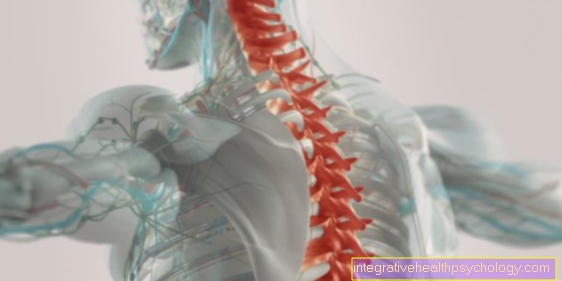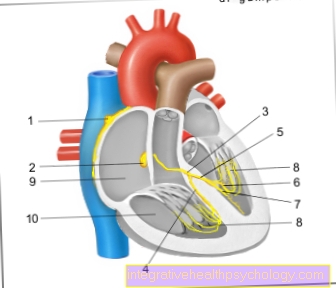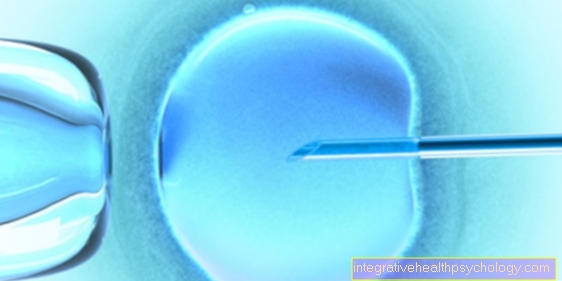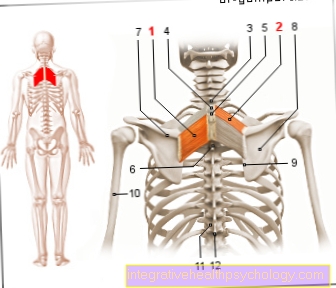Limbic system
introduction

Under the term "Limbic system“One understands a functional unit localized in the brain, which is mainly used to process emotional impulses.
In addition, the limbic system controls the development of drive behavior.
The processing of essential components of intellectual performance are also assigned to tasks of the limbic system.
In connection with these complex processes, however, the limbic system cannot be viewed as a separate functional unit. Rather, the limbic system works in harmony with a large number of nerve cells in the cerebral cortex.
Accordingly, the emergence of emotions and drive behavior is based on a lively exchange of information between many parts of the brain.
Limbic System Anatomy
The under the term "Limbic system“Known functional unit of the Brain includes several anatomical structures.
The individual components of the limbic system form a double ring within the brain around the so-called Basal ganglia and the Thalamus.
Historically, the individual structures of the limbic system are based on old parts of the Cerebral cortex (Paleopallium and Archipallium) and cells located just below the cerebral cortex.
The limbic system is anatomically divided into:
- Hippocampus
- Fornix
- Corpus mamillare
- Cingulate gyrus
- Corpus amygdaloideum (Almond kernel)
- the anterior nuclei of the thalamus
- Parahippocampal gyrus
- Septum pallucidum
The individual components of the limbic system are in close contact with different regions of the entire brain and are able to process complex information.
Hippocampus
The hippocampus is one of the oldest structures in the brain in evolutionary terms.
The exact location of the hippocampus is in the Temporal lobe. Each of the two hemispheres has a hippocampus.
As a central switching station, it serves as an important part of the "limbic system“Known functional complex.
The hippocampus itself is made up of excitatory Neurons, who get their information mainly from the Cerebral cortex receive.
In this part of the limbic system, information from various sensory brain areas come together. This information is processed in the nerve cells of the hippocampus and sent back to the cerebral cortex.
One of the most important functions of this part of the limbic system is the Memory consolidation.
This means that the direct transfer of information from the Short term in the Long-term memory controlled by the hippocampus (Long term potentiation).
Since the hippocampus receives impulses from almost all areas of the Cerebral cortex receives, all impressions of consciousness pass through it.
Specific cells of this part of the limbic system (so-called pyramidal cells) also have a Local memory.
The perception of exactly where the person is at the moment is therefore also controlled by the hippocampus.
In addition, the hippocampus serves as a species News detector.
Novel information passing through this structure is immediately prepared for storage.
Known information, however, can be called up again and networked.
Fornix
The so-called fornix consists of a pronounced strand of fibers that connects the hippocampus with the corpus mamillare above the third ventricle.
As part of the "Limbic system“The well-known functional circle, the fornix is also involved in the transfer of information from short-term to long-term memory.
Read more on the subject here: Long-term memory
Corpus mamillare
The corpus mamillare is a paired part of the limbic system on the underside of the Brain between the two Cerebral legs.
The corpus mamillare is in direct connection with the so-called Papez neuron circle.
The previously assumed function of this structure is now being called into question, since it is assumed that not the corpus mamillare itself, but the Amygdala, for the essential control emotional processes responsible for.
Corpus amygdaloideum (amygdala)
The amygdaloid corpus (Amygdala) is a paired core area that is located in the middle part of the Temporal lobe is located.
From a functional point of view, the amygdala is one of theLimbic system“Known functional unit.
The important function of the amygdala is that Control of emotional influences. It should be involved in the development of feelings of fear and the evaluation of emotional situations.
In general, the corpus amygdaloideum evaluates external impulses and initiates coordinated vegetative reaction patterns.
A loss of function of this part of the limbic system has a pronounced effect Loss of anxiety result.
In this way, if the amygdala is damaged, vital warning and defense reactions are lost.
Furthermore, it is now assumed that the amygdala has a decisive influence on the Sex drive exercises.
Typical diseases that are related to damage and / or malfunction of this part of the limbic system are Memory problems, autism, depressions and Phobias.
Cingulate gyrus
The cingulate gyrus (Synonym: belt winding) forms the inner part of the Cerebrum.
As a belt-shaped structure, it rests on the beam and runs from it Forebrain backwards.
At the cellular level, this structure of the limbic system can be divided into a front (pars posterior) and a rear (pars posterior) Divide the area.
From a functional point of view, the posterior cingulate gyrus is in close contact with the nerve cells of the Forebrain, especially with the Temporal and frontal lobes.
This area works with the hippocampus to control the spatial memory involved.
The anterior cingulate gyrus forms a network to the amygdala, the hippocampus, the nucleus accumbens, the thalamus and the islet cells.
Its most important task is to weigh contradicting impulses against each other and ultimately one Decision to act hold true.
Dysfunction of the limbic system
Since the term "limbic systemIf combined structures are involved in a number of manufacturing processes, one or more parts of this system can be disrupted severe limitations in cognitive abilities to make noticable.
Above all, the inability to assess emotional situations is attributed to functional disorders in the limbic system.
Furthermore, there are memory disorders, post-traumatic stress disorders, narcolepsy, depressions and Phobias usually on dysfunction of the limbic system.
The exact assignment of the individual diseases to a specific structure of the limbic system is not yet possible. Nevertheless, according to the current state of research, it is assumed that, for example, the Alzheimer's disease is based on direct damage to the hippocampus.







-mit-skoliose.jpg)





















